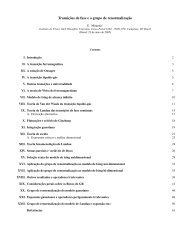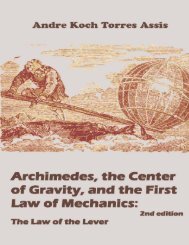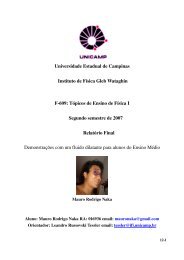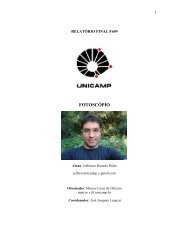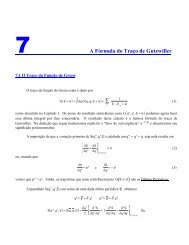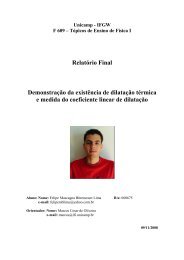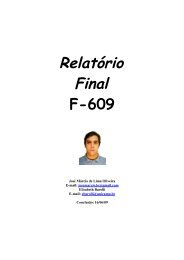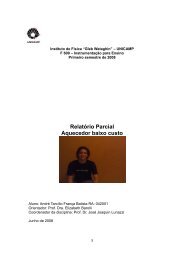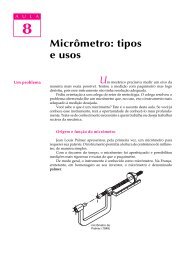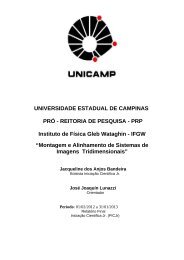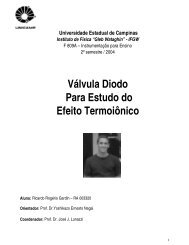The Experimental and Historical Foundations of Electricity - Unicamp
The Experimental and Historical Foundations of Electricity - Unicamp
The Experimental and Historical Foundations of Electricity - Unicamp
You also want an ePaper? Increase the reach of your titles
YUMPU automatically turns print PDFs into web optimized ePapers that Google loves.
the disk.<br />
plastic straw<br />
disk <strong>of</strong> thin cardboard<br />
Figure 7.5: Coulomb’s pro<strong>of</strong> plane. This is also a collector but will be referred<br />
to as a pro<strong>of</strong> plane for clarity when describing the following experiments.<br />
<strong>The</strong>se charge collectors will be used in some <strong>of</strong> the experiments described<br />
here.<br />
7.3 <strong>The</strong> Electric Polarization <strong>of</strong> Conductors<br />
Experiment 7.3<br />
We saw in Experiment 6.12 that thin cardboard is a conductor, while plastic<br />
is an insulator. We use this fact to build an insulated conductor: A horizontal<br />
thin cardboard disk 15 cm in diameter is supported by four vertical plastic<br />
straws attached to appropriate supports, such as the supports <strong>of</strong> the electric<br />
pendulums. We place three Coulomb pro<strong>of</strong> planes on the top <strong>of</strong> the disk, aligned<br />
along a diameter <strong>of</strong> the disk, one at the center <strong>and</strong> the other two close to the<br />
opposite edges. We call them 1, 2, <strong>and</strong> 3, with the 2nd pro<strong>of</strong> plane at the center<br />
<strong>of</strong> the disk. Initially we touch the disk with our finger in order to discharge it.<br />
We now begin the experiment to study the distribution <strong>of</strong> charges on this disk<br />
in the presence <strong>of</strong> other nearby charged bodies. To do this, we first charge two<br />
electroscopes, one positively <strong>and</strong> the other negatively. We place them far away<br />
from one another <strong>and</strong> from this horizontal disk. We also will utilize a third<br />
discharged electroscope.<br />
We charge a straw negatively along its entire length when we rub it in our<br />
hair. It should then be stood vertically on an appropriate support. <strong>The</strong> middle<br />
<strong>of</strong> this straw should be at the same height as the horizontal plane <strong>of</strong> the disk.<br />
<strong>The</strong> rubbed straw is brought near the disk, without touching it, close to pro<strong>of</strong><br />
plane1(Figure7.6). <strong>The</strong>ywillthenbeinthefollowingsequence: negativestraw,<br />
pro<strong>of</strong> planes 1, 2, <strong>and</strong> 3, respectively. <strong>The</strong> negative straw should be about 2 cm<br />
from the closest edge <strong>of</strong> the disk. We remove pro<strong>of</strong> plane 2 <strong>and</strong> bring it close to<br />
the discharged electroscope. Nothing happens, indicating that it is electrically<br />
neutral. We can put it back in its original place. We now remove pro<strong>of</strong> plane 1<br />
<strong>and</strong> slowly bring it near the discharged electroscope, without making contact.<br />
<strong>The</strong> strip <strong>of</strong> this electroscope is attracted by this pro<strong>of</strong> plane, indicating that the<br />
pro<strong>of</strong> plane is charged. We then slowly bring it near the negative <strong>and</strong> positive<br />
electroscopes, asalwayspreventingthemfromcomingintocontact. <strong>The</strong>charged<br />
pro<strong>of</strong> plane attracts the strip on the negative electroscope <strong>and</strong> repels the strip<br />
on the negative electroscope. From these facts we conclude that pro<strong>of</strong> plane<br />
177



